
Silesia is a historical region of Central Europe that lies mostly within Poland, with small parts in the Czech Republic and Germany. Its area is approximately 40,000 km2 (15,400 sq mi), and the population is estimated at 8,000,000. Silesia is split into two main subregions, Lower Silesia in the west and Upper Silesia in the east. Silesia has a diverse culture, including architecture, costumes, cuisine, traditions, and the Silesian language. The largest city of the region is Wrocław.

Silesian Voivodeship is a voivodeship, or province, in southern Poland centered on the historic region known as Upper Silesia, with Katowice serving as its capital.

Katowice is the capital city of the Silesian Voivodeship in southern Poland and the central city of the Katowice urban area. As of 2021, Katowice has an official population of 286,960, and a resident population estimate of around 315,000. Katowice is a central part of the Metropolis GZM, with a population of 2.3 million, and a part of a larger Upper Silesian-Moravian metropolitan area that extends into the Czech Republic and has a population of around 5 million people, making it one of the most populous metropolitan areas in the European Union.

Sosnowiec is an industrial city county in the Dąbrowa Basin of southern Poland, in the Silesian Voivodeship, which is also part of the Metropolis GZM municipal association. Located in the eastern part of the Upper Silesian Industrial Region, Sosnowiec is one of the cities of the Katowice urban area, which is a conurbation with the overall population of 2.7 million people; as well as the greater Upper Silesian-Moravian metropolitan area populated by about 5.3 million people. The population of the city is 189,178 as of December 2022.
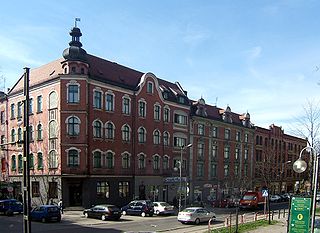
Ruda Śląska is a city in Silesia in southern Poland, near Katowice. It is a city in the Metropolis GZM, a metropolis with a population of two million. It is in the Silesian Highlands, on the Kłodnica River.

Upper Silesia is the southeastern part of the historical and geographical region of Silesia, located today mostly in Poland, with small parts in the Czech Republic. The area is predominantly known for its heavy industry.

The Katowice-Ostrava metropolitan area is a polycentric metropolitan area in southern Poland and northeastern Czech Republic, centered on the cities of Katowice and Ostrava, and has around 5 million inhabitants. Geographically, it is located mainly in Upper Silesia, with small parts of the area also in the historical regions of Moravia and Lesser Poland. Administratively, it is located in the three administrative units : mainly Silesian Voivodeship and a small western part of Lesser Poland Voivodeship in Poland, and also a small eastern part of Moravian-Silesian Region in the Czech Republic.
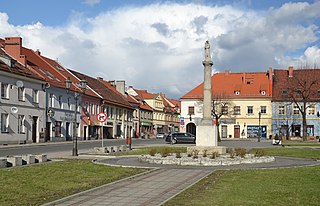
Pyskowice is a city in Silesia in southern Poland, near Katowice. Outer city of the Metropolis GZM – metropolis with the population of 2 million. Located in the Silesian Highlands.
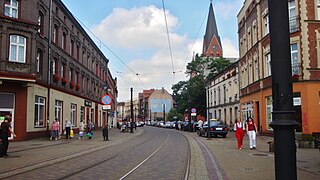
Świętochłowice is a city with powiat rights in Silesia in southern Poland, near Katowice. It is also one of the central cities of the Metropolis GZM, with a population of 2 million, and is located in the Silesian Highlands, on the Rawa River.
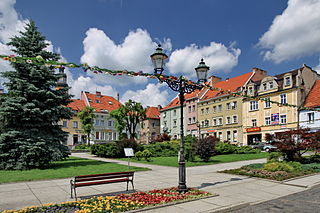
Wodzisław Śląski is a city in Silesian Voivodeship, southern Poland with 47,992 inhabitants (2019). It is the seat of Wodzisław County.
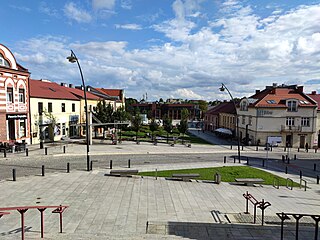
Jaworzno is a city in southern Poland, near Katowice. It lies in the Silesian Highlands, on the Przemsza river. Jaworzno belongs to Lesser Poland and despite belonging to Silesian Voivodeship since 1999, Jaworzno is not part of Silesia. The city is situated in the Silesian Voivodeship since its formation in 1999, previously (1975–1999) it was in Katowice Voivodeship. Jaworzno is one of the cities of the 2,7 million conurbation – Katowice urban area and within a greater Upper Silesian-Moravian metropolitan area populated by about 5,294,000 people. The population of the city is 89,350 (2021).
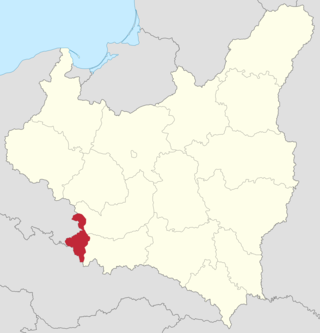
The Silesian Voivodeship was an autonomous province (voivodeship) of the Second Polish Republic. The bulk of its territory had formerly belonged to the German/Prussian Province of Silesia and became part of the newly reborn Poland as a result of the 1921 Upper Silesia plebiscite, the Geneva Conventions, three Upper Silesian Uprisings, and the eventual partition of Upper Silesia between Poland, Germany and Czechoslovakia. The remainder had been the easternmost portion of Austrian Silesia which was partitioned between Poland and Czechoslovakia following the collapse of Austria-Hungary, the Polish–Czechoslovak War and the Spa Conference of 1920. The capital of the voivodeship was Katowice.

The Silesian Autonomy Movement, abbreviated as RAŚ, is a movement officially declaring its support for the autonomy of Silesia as part of a unified Europe. The association was founded in January 1990 by Rudolf Kołodziejczyk and is based in the Polish part of Upper Silesia. RAŚ sees the Silesians as a "separate nation" rather than primarily as Poles, Germans or Czechs.

The Metropolis GZM is a metropolitan unit composed of 41 contiguous municipalities in the Silesian Voivodeship of Poland. The seat of the metropolitan council is Katowice, the largest city of the region and the voivodeship capital. With a population of over 2 million, the core of the Metropolis GZM is one of the largest urban areas in the European Union. The area of the metropolis largely coincides with the metropolitan area of the Katowice urban area, which is a part of the wider polycentric transnational Katowice-Ostrava metropolitan area, the latter with a population of 5–5.3 million people.

The Upper Silesian Coal Basin is a coal basin in Silesia, in Poland and the Czech Republic.

The Upper Silesian Industrial Region is a large industrial region in Poland. It lies mainly in the Silesian Voivodeship, centered on Katowice.

The Rybnik Coal Area is an industrial region in southern Poland. It is located in the Silesian Voivodeship, in a basin between the Vistula and Oder rivers, sited on the Rybnik Plateau between Katowice to the north and Ostrava on the south-west. It is part of the Upper Silesian-Moravian metropolitan area populated by 5,294,000 people and the Kraków-Katowice-Ostrava metropolitan region populated by about 7 million. According to scientific description by Paweł Swianiewicz and Urszula Klimska this area has 507,000 people, according to European Spatial Planning Observation Network - 634,000 people. Area: about 1,300 km2.

The Katowice urban area, also known as the Upper Silesian urban area, is an urban area/conurbation in southern Poland, centered on Katowice. It is located in the Silesian Voivodeship and in a small part of the Lesser Poland Voivodeship. The Katowice urban area is the largest urban area in Poland and 21st largest urban area in the European Union. According to Demographia, its population is 1,903,000.

TVP3 Katowice a.k.a. TV Katowice also Television Katowice is one of the regional branches of the TVP, Poland's public television broadcaster. It serves the entire Silesian Voivodeship with particular dedication to the Metropolis GZM and Katowice metropolitan area.


















